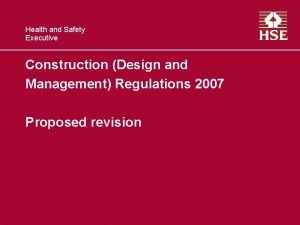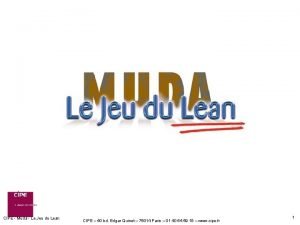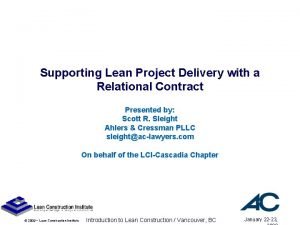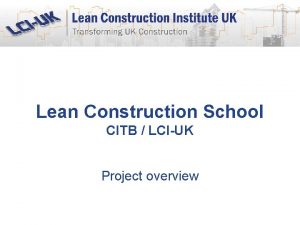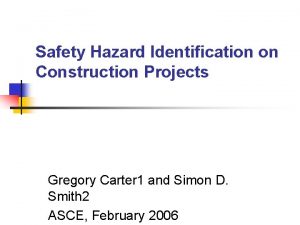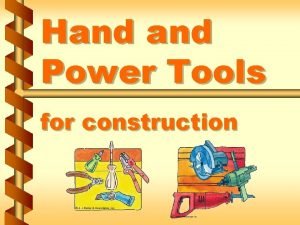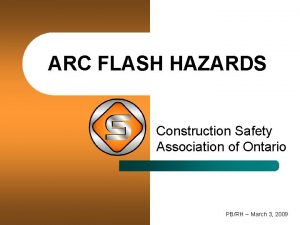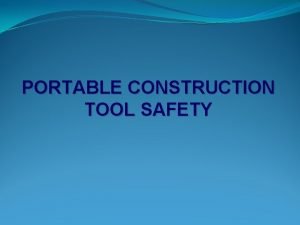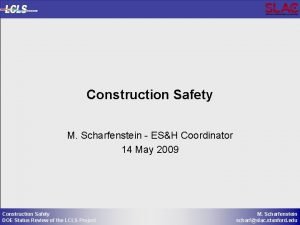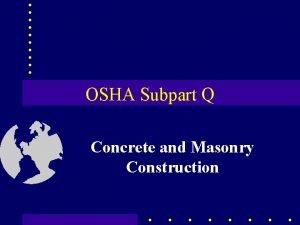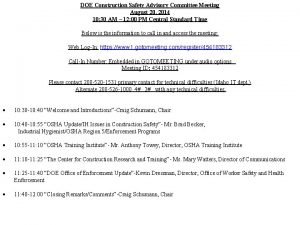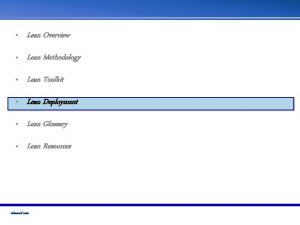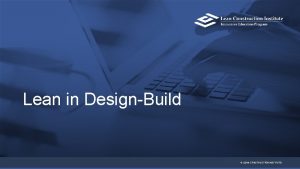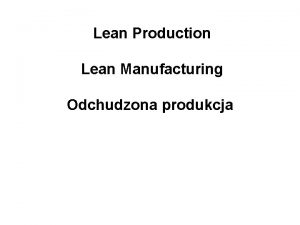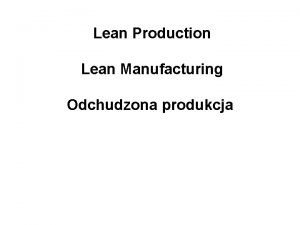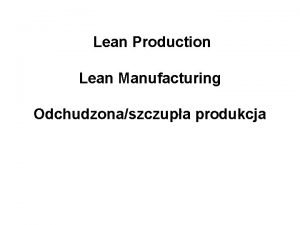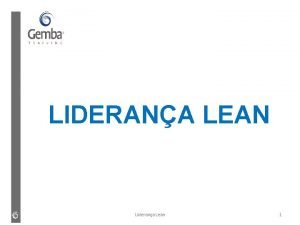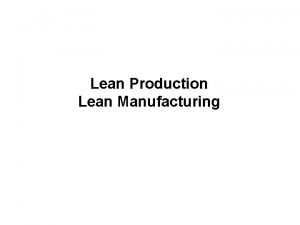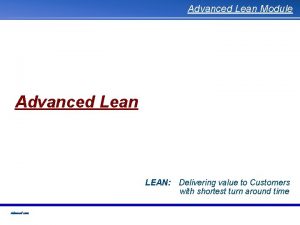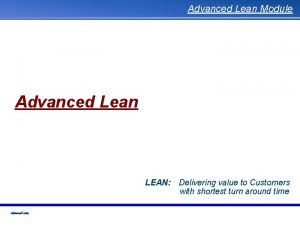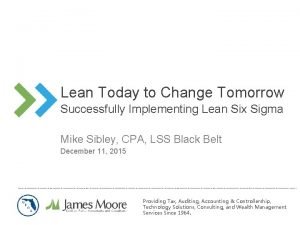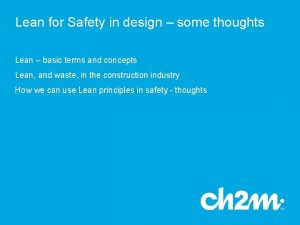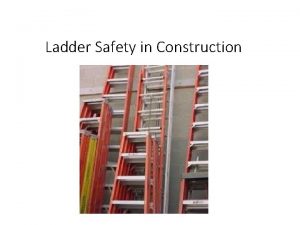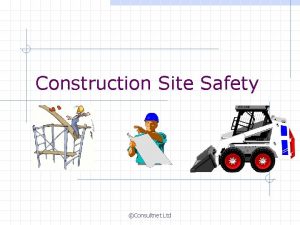Implementing Lean in Construction Health Safety synergies of

































- Slides: 33

Implementing Lean in Construction Health & Safety synergies of Lean CIRIA Publication C 769 Steve Matthews & Doug Potter, WSP

Steve Matthews WSP INTRODUCTION IMPLEMENTING LEAN IN CONSTRUCTION C 769 – HEALTH AND SAFETY SYNERGIES OF LEAN

CIRIA C 769 & Lean • One of a series of guides – www. ciria. org/lean • “Headline” or “Entry screen” – provide insight • Contributing authors • Steering group – clients, contractors, consultants, universities • Background – civil, mechanical, production, Lean • Use of cross sector expertise • Fundamental principle of TRIZ

Development of the document • Initial content – steering committee comment • Early meeting • • Recognised the Lean/H&S linkage Realigned the project and document structure Aligned with consideration of Whole Life Cycle Reduced “text book on Lean” Included enough to be free-standing and demonstrate correlation Highlighted key tools Case studies to demonstrate the practical application

Document structure Part 1 6. Framework for illustrating use of Lean tools 1. Introduction 2. H&S issues in construction 3. Lean construction 4. Case studies 5. Applying the principles of Lean Part 2 2. 2 H&S symptoms & underlying causes 3. 3 Introduction to main groups of approaches and tools and their applicability (CIRIA 730) Appendix Implementing Lean 7. Mapping Lean tools 8. Illustrating the use of Lean tools Data sheets based on • Asset life cycle • Illustrating typical use of Lean tools

Key elements considered • Vision • Tools (non exclusive!) • • Collaborative Planning Problem solving 5 S (6 with Safety) Visual Management Process improvement Operations improvement Other

Health & Safety – Statistics – 1 Slips, trips & falls (23%) Estimated 66000 self-reported nonfatal injuries Lifting and handling (22%) Annual average 2013/14 to 2015/16 Falls from height (20%) Struck by object (11%)

Health & Safety – Statistics – 2 Musculo-skeletal disorders (64%) Estimated 79000 self reported illnesses Stress, depression, anxiety (18%) Annual average 2013/14 to 2015/16 Other illness (18%)

Hazards & Causes Pressures lead to stress, affect mental well being Health Exposure to chemical, combustion, noise, dust hazards Musculo-skeletal disorders – vibration inducing equipment Physical Slips/trips/falls – poor site management/ materials storage Physical injuries – poor site management, vehicle impact Working from height Locational Working under suspended loads/ Falling objects Poor ergonomics

Underlying Causes - 1 • Risk assessment and communication • • • Failure to eliminate risks including from materials and moving plant Failure to reduce residual risks ALARP Lack of principal designer activity – e. g. • Reliance on generic risk assessment • Lack of opportunity for holistic (team) approach – contract conditions? • Lack of principal contractor activity - e. g. • Lack of opportunity for holistic approach and influence design • Reliance on generic risk assessment • Lack of issue log/risk register - owned/used by all co-operatively

Underlying causes - 2 • Information/changes • • • Lack of information (difficult to acquire in a timely manner, or late) Information not reaching the right people Changes that confuse people Late changes that are confusing, no time for thought, review or coordination Lack of site communication between contractors and workers Communication with users for the operational phases (e. g. travelling public, maintenance community)

Underlying causes - 3 • People • • Failure to co-operate & coordinate (generally, all parties) Lack of competence or access to competence Lack of leadership On-site changes Personality issues Blame culture Contractual pressures Financial pressures

Health & Safety - Lean tool application Risk area Lean tool Applying ERIC at planning & design stage Design For Manufacture Assembly (DFMA) Musculo-skeletal disorders DFMA Locational risk Visual management Injuries from poor site set-up Lean collaborative planning Slips, trips and falls 5(6)S workplace organisation Pressures affecting stress/well being Collaborative planning, standardised operations Lack of timely information provision Process mapping, SIPOC Avoiding risks from time pressures Collaborative short term planning

WHERE ARE WE NOW?





Resume • Overview of document • Hazards & Causes • Indication of use of Lean tools • Potentially powerful lever – we should develop • Early survey suggests there is scope to do so • Linked to practical examples • Detailed look at application of these

M 1 J 34 ALR Smart Motorway Infrastructure modelled in BIM Doug Potter WSP (formerly Mouchel) CASE STUDY HIGHWAYS ENGLAND M 1 JN 28 TO J 35 A SMART MOTORWAY IMPROVEMENT

M 1 J 28 -35 a - Scheme Objectives • Improve traffic flows to 60 km of the M 1 (S. Yorkshire/N. Derbyshire) • Minimise disruption to the travelling public • Deliver a safe working environment • Deliver to an accelerated programme • Deliver innovations and savings • Target cost reimbursable contract • Work within a scheme budget of £ 350 m

M 1 J 28 -35 a - Installation of Drainage Attenuation Tanks in the verge Issues: • Limited knowledge of existing drainage assets • Constrained working area often on steep batters • Limited vehicular access through the site • Obstructive to other work activities • Potential critical path activity • Recognised as key risk to scheme

M 1 J 28 -35 a Smart Motorway Improvement Combined site delivery team: • • Highways England PM Principal Contractor – Costain Lead Designer – WSP (formerly Mouchel) Quantity Surveyors Corderoy

M 1 J 28 -35 a Smart Motorway Improvement Project status • • • Traditional 2 -D Design 160 attenuation sites to construct in phase 1 Accelerated Delivery Programme Extensive site – 32 km in length (60 km in total) Low level Li. DAR survey data available High volumes of traffic

M 1 J 28 -31 – Phase 1 Proposal • Use of Lean techniques to improve delivery of drainage attenuation solutions • Collaborative Planning • Visual management • Use of TILOS Planning Software • BIM modelling – Site based BIM Design Team – Costain Construction Team • Process Mapping

Plan: • • • Combined drainage delivery team Weekly meetings Planning room created Use of TILOS Planning Software Scheme split into 6 links Each link: • Construction activities plotted linearly on A 1 • Weekly review of each activity within each link – – Access Work load Resource availability Design delivery

M 1 J 28 -31 a Tilos Board

Do: - Collaborative Planning session • Weekly – (Drainage) • Topographical survey • Develop initial 3 D BIM attenuation design (visual review) • Review access constraints and potential clashes using 3 D model • Consider buildability issues, minimise excavation works and therefore reduce temporary works extents

Check: • Finalise 3 D design and issue 3 D schematics as Works Information • Contractor orders material or takes material from stockpile

Build: • • • Monitor construction programme Feedback to weekly TILOS meeting Adjust programme based on weekly outputs achieved Re-priorities target areas dependent on access availability Stockpile material to speed design through to construction to improve turn round times Review hazards, productivity and capture lessons learned and feedback to the project team

Capture as-built records

Outcomes, Improvements and Results • Collaboration, visualisation - considered buildability issues, • Minimised excavations, reduced temporary works extents • Identified Hazards and unnecessary exposure • Eliminate, Reduce, Isolate, Control • Significant H&S improvements to both site staff and travelling public • Minimal technical queries, reduced re-work • Through site access maintained - minimal delays to other work activities • Improved as-built data capture – lessons learned for future use • >10 week saving on programme, £ 10 m saving on budget

QUESTIONS?
 00101-15 basic safety
00101-15 basic safety Basic safety orientation
Basic safety orientation Health and safety executive construction
Health and safety executive construction Reactik jeu correction
Reactik jeu correction Lean construction définition
Lean construction définition Lean construction
Lean construction Lean construction
Lean construction Lean construction workshop
Lean construction workshop Gregory carter
Gregory carter Construction tool safety
Construction tool safety Arc flash study ontario
Arc flash study ontario Compactor hazards
Compactor hazards Construction safety system
Construction safety system A limited access zone must
A limited access zone must Doe
Doe Hrd program implementation
Hrd program implementation Chapter 7 strategic management
Chapter 7 strategic management Mis issues in strategy implementation
Mis issues in strategy implementation Chapter 7 strategic management
Chapter 7 strategic management Tripod pricing strategy
Tripod pricing strategy Implementing merchandise plans
Implementing merchandise plans Designing and implementing brand strategies
Designing and implementing brand strategies Designing and implementing brand architecture strategies
Designing and implementing brand architecture strategies Porfolio assessment
Porfolio assessment Planning and implementing crm projects
Planning and implementing crm projects Qsen core competencies
Qsen core competencies Challenges of implementing predictive analytics
Challenges of implementing predictive analytics Bert spector
Bert spector Mis issues in strategy implementation
Mis issues in strategy implementation Access rights definition
Access rights definition Problems in implementing portfolio management
Problems in implementing portfolio management Matching structure with strategy
Matching structure with strategy Toyota brand hierarchy
Toyota brand hierarchy Implementing nfpa 1600 national preparedness standard
Implementing nfpa 1600 national preparedness standard


